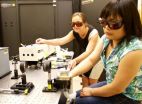(Press-News.org) In lab experiments using tissue samples cultured from cystic fibrosis patients, scientists at the UNC School of Medicine and the UNC Marsico Lung Institute have shown that a new CF drug counteracts the intended beneficial molecular effect of another CF drug.
The finding, published today in the journal Science Translational Medicine, shows how a mutant CFTR protein becomes unstable and loses its ability to function properly when in the presence of the two drugs. The research offers several insights into how novel CF pharmacotherapies could be improved.
“In our human airway epithelial model system, one of the drugs destabilizes and deactivates the protein that the other drug tries to correct,” said Martina Gentzsch, PhD, an assistant professor of cell biology and physiology and senior author of the UNC Science Translational Medicine paper. “Our data suggest that drug developers should take this destabilization effect into account in order to alleviate CF symptoms to a greater degree.”
People with cystic fibrosis have two faulty copies of the CFTR gene. In one type of mutation, patients don’t have enough CFTR proteins that transit normally to the cell surface. In other patients, mutant CFTR proteins that do transit to the cell surface don’t function properly. Both genetic mutations lead to poor mucus clearance from lungs, chronic lung infections, bouts of inflammation, and a decreased ability to breathe properly, among other symptoms.
Scientists create compounds called “correctors” to fix the CFTR proteins so that proper amounts transit to the cell surface where they can serve as chloride channels to help maintain a well-hydrated airway. Scientists also create compounds called “potentiators” to activate the CFTR channels at the cell surface to maintain the proper balance of electrolytes in fluids, including those found inside lungs.
Between 3 and 5 percent of CF patients have a specific genetic mutation that allows epithelial cells to transit enough CFTR proteins to the cell surface, but the chloride channels have a defective activation. A potentiator called VX-770, also known as ivacaftor, has proven very effective for the small subset of CF patients with this specific genetic mutation.
However, the vast majority of CF patients have the “transit” mutation and insufficient CFTR proteins at the cell surface; these patients may need a corrector and a potentiator.
In Gentzsch’s study, UNC postdoctoral fellow Deborah Cholon, PhD, conducted lab experiments using tissue samples from CF patients who have the most common CFTR “transit” genetic mutation (ΔF508). Gentzsch’s team grew cultured CF epithelial cells in an environment that mimicked a human lung. Then the researchers treated the cells for two days with a corrector compound called VX-809, also known as lumacaftor. They observed that the amount of CFTR protein transiting the cell surface appropriately increased. But when they acutely (in seconds) added the potentiator VX-770, the corrected CFTR protein exhibited a brief increase in function that rapidly waned, a sign that the corrected CFTR protein was losing its ability to function as an ion channel.
In a separate experiment, Gentzsch’s team treated the CF cells for two days with a potentiator and a corrector at the same time; this is how a drug would be given to patients. Gentzsch found that the potentiator compound chronically destabilized the CFTR protein, and that the destabilization was dependent upon the dose of VX-770. That is, the experiments showed that the potentiator cancelled out the intended effect of having a corrected CFTR protein at the epithelial surface.
“The result was striking,” Gentzsch said. “The potentiator acted like an inhibitor of the corrector compound. We could see the corrected CFTR protein disappearing.”
The findings come one month after results from a clinical trial showed that the two-drug approach increased lung function in CF patients by 2.2 to 3.6 percent. This result was statistically significant, but Charles Esther, MD, PhD, a clinical associate professor and one of the UNC coauthors, said that it would be difficult for many CF patients to perceive this level of improved lung function on a day-to-day basis. However, Esther and the UNC coauthors, who were not involved in the clinical trial, said that a statistically significant increase in lung function is thought to lead to fewer CF-related flare-ups over the course of a year.
Data from the clinical trial did show that the combination therapy substantially decreased the number of pulmonary exacerbations and hospitalizations, while also beneficially increasing the weight of CF patients. Gentzsch, Esther, and the UNC coauthors of the Science Translational Medicine paper agree that these clinical outcomes are promising and set the stage for new therapies for CF patients.
Gentzsch noted potential reasons to explain why patients in the clinical trial saw benefit from the two drugs even though her team’s lab experiments produced evidence to the contrary. First, the destabilizing effects of VX-770 on the corrected CFTR protein might be less robust in the human body than were the effects seen in lab tests using human lung cells. In addition, cell culture studies lasted two days in Gentzsch’s study, whereas the clinical studies lasted for months.
Gentzsch also said that the drugs may produce beneficial effects by mechanisms unrelated to correcting the mutant CFTR protein. For example, Gentzsch’s team found that VX-770 can decrease the function of a sodium channel in CF epithelial cells and other cells. Researchers also have found that VX-770 has antibacterial properties.
“The trial is important for gene research and may be a proof of principle that targeting the most common mutation in cystic fibrosis is an effective approach for treatment of most patients,” Gentzsch said. “But evidence of corrective effects on CFTR in the clinic requires further study. And we think that many people with CF need therapies that improve their health to a greater degree. We hope that our studies will help in this endeavor.”
INFORMATION:
This research was funded by the National Institutes of Health, the Cystic Fibrosis Foundation, and the Else Kröner-Fresenius-Stiftung.
Other authors of the study include: UNC research specialists Nancy L. Quinney and Leslie Fulcher; UNC postdoctoral fellow Jhuma Das, PhD; Nikolay Dokholyan, PhD, the Michael Hooker Distinguished Professor of Biochemistry and Biophysics; Scott Randell, PhD, Associate Professor of Cell Biology and Physiology; and Richard Boucher, MD, the Director of the UNC Marsico Lung Institute and the James C. Moeser Eminent Distinguished Professor of Medicine.
UNC researchers find unsuspected characteristics of new CF drugs, offering potential paths to more effective therapies
The study, led by Martina Gentzsch, PhD, provides evidence that could help drug developers improve compounds aimed at correcting CFTR proteins in cystic fibrosis patients
2014-07-23
ELSE PRESS RELEASES FROM THIS DATE:
Spinach could lead to alternative energy more powerful than Popeye
2014-07-23
WEST LAFAYETTE, Ind. — Spinach gave Popeye super strength, but it also holds the promise of a different power for a group of scientists: the ability to convert sunlight into a clean, efficient alternative fuel.
Purdue University physicists are part of an international group using spinach to study the proteins involved in photosynthesis, the process by which plants convert the sun's energy into carbohydrates used to power cellular processes.
"The proteins we study are part of the most efficient system ever built, capable of converting the energy from the sun into chemical ...
The birth of topological spintronics
2014-07-23
The discovery of a new material combination that could lead to a more efficient approach to computer memory and logic will be described in the journal Nature on July 24, 2014. The research, led by Penn State University and Cornell University physicists, studies "spin torque" in devices that combine a standard magnetic material with a novel material known as a "topological insulator." The team's results show that such a scheme can be 10 times more efficient for controlling magnetic memory or logic than any other combination of materials measured to date.
"This is a really ...
Strategy proposed for preventing diseases of aging
2014-07-23
AUDIO:
Some researchers are proposing that changing how medical care is delivered could help prevent multiple chronic diseases and extend healthy lifespan. The idea, they argue, would be to target the...
Click here for more information.
Medicine focuses almost entirely on fighting chronic diseases in a piecemeal fashion as symptoms develop. Instead, more efforts should be directed to promoting interventions that have the potential to prevent multiple chronic diseases and extend ...
Sleep deprivation may increase susceptibility to false memories
2014-07-23
Not getting enough sleep may increase the likelihood of forming false memories, according to research published in Psychological Science, a journal of the Association for Psychological Science.
In a study conducted by psychological scientist Steven J. Frenda of the University of California, Irvine and colleagues, sleep-deprived people who viewed photographs of a crime being committed and then read false information about the photos were more likely to report remembering the false details in the photos than were those who got a full night's sleep.
Research has demonstrated ...
Satellite shows Atlantic Tropical Depression degenerate
2014-07-23
NOAA's GOES-East satellite captured imagery of the Atlantic Ocean's Tropical Depression 2 is it degenerated into a tropical wave on July 23.
At 1445 UTC (10:45 a.m. EDT), NOAA's GOES-East satellite captured an image of what was once Tropical Depression 2 (TD2), about 400 miles east of the Lesser Antilles. The GOES-East visible satellite imagery indicated that the depression weakened since July 22. TD2 appeared as just a weak swirl of clouds with no strong thunderstorms or deep convection. The GOES image was created by NASA/NOAA's GOES Project at NASA's Goddard Space Flight ...
Gene inhibitor, salmon fibrin restore function lost in spinal cord injury
2014-07-23
Irvine, Calif., July 23, 2014 — A therapy combining salmon fibrin injections into the spinal cord and injections of a gene inhibitor into the brain restored voluntary motor function impaired by spinal cord injury, scientists at UC Irvine's Reeve-Irvine Research Center have found.
In a study on rodents, Gail Lewandowski and Oswald Steward achieved this breakthrough by turning back the developmental clock in a molecular pathway critical to the formation of corticospinal tract nerve connections and providing a scaffold so that neuronal axons at the injury site could grow ...
Fires in the Northern Territories July 2014
2014-07-23
Environment Canada has issued a high health risk warning for Yellowknife and surrounding area because of heavy smoke in the region due to forest fires. In the image taken by the Aqua satellite, the smoke is drifting eastward along normal wind patterns. Fire is an obvious health hazard, but the smoke that comes from fires is not quite so obvious and its effects are insidious.
The smoke released by any type of fire (forest, brush, crop, structure, tires, waste or wood burning) is a mixture of particles and chemicals produced by incomplete burning of carbon-containing ...
Study links enzyme to autistic behaviors
2014-07-23
RIVERSIDE, Calif. — Fragile X syndrome (FXS) is a genetic disorder that causes obsessive-compulsive and repetitive behaviors, and other behaviors on the autistic spectrum, as well as cognitive deficits. It is the most common inherited cause of mental impairment and the most common cause of autism.
Now biomedical scientists at the University of California, Riverside have published a study that sheds light on the cause of autistic behaviors in FXS. Appearing online today (July 23) in the Journal of Neuroscience, and highlighted also on the cover in this week's print issue ...
This week from AGU: New Oso report, rockfall in Yosemite, and earthquake models
2014-07-23
From AGU's blogs: Oso disaster had its roots in earlier landslides
A research team tasked with being some of the first scientists and engineers to evaluate extreme events has issued its findings on disastrous Oso, Washington, landslide. The report studies the conditions and causes related to the March 22 mudslide that killed 43 people and destroyed the Steelhead Haven neighborhood in Oso, Washington. The team from the Geotechnical Extreme Events Reconnaissance (GEER) Association, funded by the National Science Foundation, determined that intense rainfall in the three ...
York University researchers use bird 'backpacks' to put wood thrushes migration on the map
2014-07-23
TORONTO, July 23, 2014 – Migratory songbirds are disappearing, and though conservationists are examining several possible reasons such as climate change, loss of habitat, acid rain and light pollution, a key piece of the puzzle has remained missing: where do these birds go once they leave their breeding sites, and what threats may they be encountering along the way?
To answer this question, a team of researchers out of York University have created the first ever migratory connectivity map produced for a songbird, using tracking from both breeding and winter sites. They ...
LAST 30 PRESS RELEASES:
Satellite data helps UNM researchers map massive rupture of 2025 Myanmar earthquake
Twisting Spins: Florida State University researchers explore chemical boundaries to create new magnetic material
Mayo Clinic researchers find new hope for toughest myeloma through off-the-shelf immunotherapy
Cell-free DNA Could Detect Adverse Events from Immunotherapy
American College of Cardiology announces Fuster Prevention Forum
AAN issues new guideline for the management of functional seizures
Could GLP-1 drugs affect risk of epilepsy for people with diabetes?
New circoviruses discovered in pilot whales and orcas from the North Atlantic
Study finds increase in risk of binge drinking among 12th graders who use 2 or more cannabis products
New paper-based technology could transform cancer drug testing
Opioids: clarifying the concept of safe supply to save lives
New species of tiny pumpkin toadlet discovered in Brazil highlights need for conservation in the mountain forests of Serra do Quiriri
Reciprocity matters--people were more supportive of climate policies in their country if they believed other countries were making significant efforts themselves
Stanford Medicine study shows why mRNA-based COVID-19 vaccines can cause myocarditis
Biobanking opens new windows into human evolution
Sky-high smoke
AI tips off scientists to new drug target to fight, treat mpox
USC researchers develop next-generation CAR T cells that show stronger, safer response in animal models
New study reveals Industrial Revolution’s uneven health impacts across England
Vine-inspired robotic gripper gently lifts heavy and fragile objects
Fingerprint of ancient seafarer found on Scandinavia’s oldest plank boat
Lunar soil analyses reveal how space weathering shapes the Moon’s ultraviolet reflectance
Einstein’s theory comes wrapped up with a bow: astronomers spot star “wobbling” around black hole
Danforth Plant Science Center to lead multi-disciplinary research to enhance stress resilience in bioenergy sorghum
Home-delivered groceries improve blood sugar control for people with diabetes facing food insecurity
MIT researchers identified three cognitive skills we use to infer what someone really means
The Iberian Peninsula is rotating clockwise according to new geodynamic data
SwRI, Trinity University to study stable bacterial proteins in search of medical advances
NIH-led study reveals role of mobile DNA elements in lung cancer progression
Stanford Medicine-led study identifies immune switch critical to autoimmunity, cancer
[Press-News.org] UNC researchers find unsuspected characteristics of new CF drugs, offering potential paths to more effective therapiesThe study, led by Martina Gentzsch, PhD, provides evidence that could help drug developers improve compounds aimed at correcting CFTR proteins in cystic fibrosis patients






